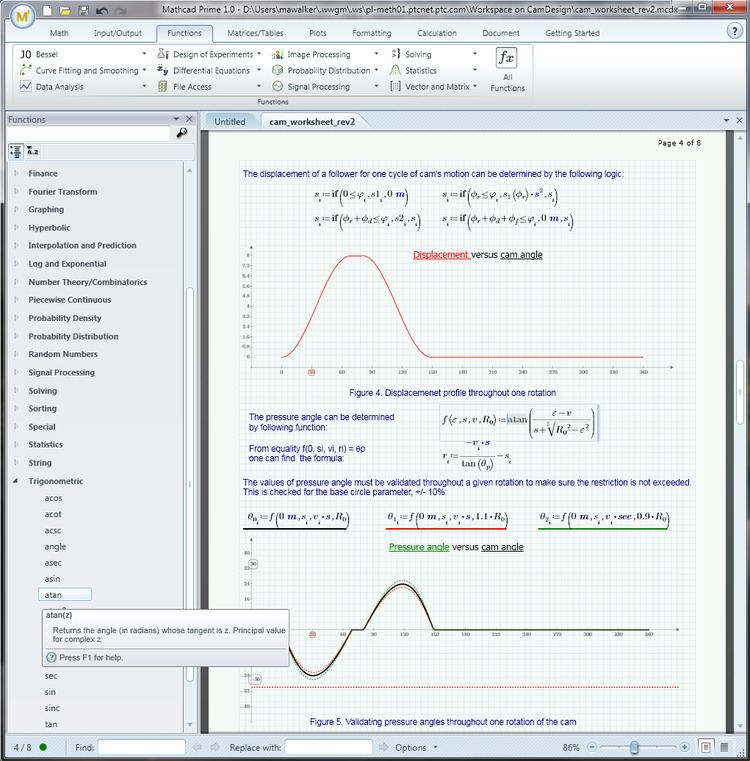Development status Active Available in 10 languages | Initial release 1986 (1986) Operating system | |
 | ||
Stable release 15.0 M045 / November 2015 (2015-11)Prime 4.0 / March 6, 2017; 7 days ago (2017-03-06) | ||
Mathcad is computer software primarily intended for the verification, validation, documentation and re-use of engineering calculations. First introduced in 1986 on DOS, it was the first to introduce live editing of typeset mathematical notation, combined with its automatic computations.
Contents
Overview
Mathcad, Parametric Technology Corporation's engineering calculation solution, is used by engineers and scientists in various disciplines – most often those of mechanical, chemical, electrical, and civil engineering. Originally conceived and written by Allen Razdow (of MIT, co-founder of Mathsoft), Mathcad is now owned by PTC and is generally accepted as the first computer application to automatically compute and check consistency of engineering units such as the International System of Units (SI), throughout the entire set of calculations. Mathcad today includes some of the capabilities of a computer algebra system, but remains oriented towards ease of use and simultaneous documentation of numerical engineering applications.
Mathcad is oriented around a worksheet, in which equations and expressions are created and manipulated in the same graphical format in which they are presented (WYSIWYG) - as opposed to authoring in plain text, an approach later adopted by other systems such as Mathematica and Maple.
Mathcad is part of a broader product development system developed by PTC, and often utilized for the many analytical touch points within the systems engineering processes. It integrates with PTC’s other solutions that aid product development, including Creo Elements/Pro, Windchill, and Creo Elements/View. Its live feature-level integration with Creo Elements/Pro enables Mathcad analytical models to be directly used in driving CAD geometry, and its structural awareness within Windchill allows live calculations to be re-used and re-applied toward multiple design models.
Summary of capabilities
The Mathcad interface allows users to combine a variety of different elements (mathematics, descriptive text, and supporting imagery) into the form of a worksheet, which is naturally readable. Because the mathematics are core to the program, the math is inherently live, dynamically recalculating as upstream values are altered. This allows for simple manipulation of input variables, assumptions, and expressions, which in turn update in real-time. The examples below serve to outline the scope of Mathcad’s capabilities, rather than to give specific details on the individual product functionality.
Although Mathcad is mostly oriented to non-programming users, it is also used in more complex projects to visualize results of mathematical modeling by using distributed computing and coupling with programs written using more traditional languages such as C++.
Current releases
As of March 2017, there are two actively maintained Mathcad releases and a free express version available to consumers:
Computer operating system platforms
Mathcad is currently a Windows-only application. Current releases of Mathcad 15.0 and Mathcad Prime 1.0 are supported on 32-bit and 64-bit versions of Windows XP, Windows Vista, and Windows 7. Currently releases are 32-bit applications only, however. While users do utilize emulation to establish other platform operability, Mathcad’s last officially supported, natively installed Mac OS release was on January 8, 1998. This version can still be run on Macintosh computers that support the Mac OS X Classic Environment or SheepShaver.
Support
After PTC’s purchase of Mathcad in 2006, changes were made to the Mathcad support policy. That change specified non-maintenance bearing licenses were no longer able to receive updates, including bug fixes, without purchasing a maintenance contract. Though disagreeable to some long-time, pre-PTC-acquisition customers, this is PTC’s standard policy for all its other products. The price of a Mathcad maintenance contract for an individual is roughly half the cost of a single-user license upgrade at the time of a major Mathcad release, and grants the user the right to receive major releases in addition to bug fixes, access to engineering content, technical support, self-service license transferring tools, and more.
The Mathcad Business Unit within PTC recently updated their support policy. For Mathcad 15.0 and future versions of Mathcad, the first year of maintenance entitlements and support will be included in the purchase or upgrade price.
As of September 2014, due to the rapidly changing technology landscape and Microsoft's retiring of the Windows XP operating system, PTC will discontinue PTC Mathcad support of the Windows Vista and XP operating systems with the release of PTC Mathcad Prime 3.1 and PTC Mathcad 15.0 M040.
